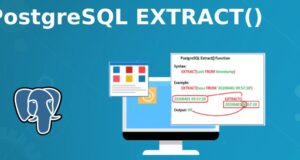REQUEST COMPLIMENTARY SQLS*PLUS LICENCE
PostgreSQL extract function

PostgreSQL extract function extracts parts from the date.
Syntax of the extract function in PostgreSQL
extract( unit from date )
Parameters and function arguments
- date – date, timestamp, time, or interval value from which a part of the date is to be extracted.
- Unit – Type of the unit of interval measurement, such as day, month, minute, hour, etc. This may be one of the following:
| unit | Explanation |
|---|---|
| century | Uses the Gregorian calendar, where the first century begins with ‘0001-01-01 00:00:00 AD’. |
| day | day of the month (1 to 31) |
| decade | The year is divided by 10 |
| dow | day per week (0=Sunday, 1=Monday, 2=Tuesday,… 6=Saturday) |
| doy | day of the week in a year (1 = first day of the year, 365/366 = last day of the year, depending on whether it is a leap year) |
| epoch | Number of seconds from ‘1970-01-01 00:00:00 UTC’ if the date value. The number of seconds in an interval, if the value is an interval. |
| hour | hour (0 to 23) |
| isodow | day of the week (1=Monday, 2=Tuesday, 3=Wednesday,… 7=Sunday) |
| isoyear | ISO 8601 (where the year begins on Monday of the week containing January 4) |
| microseconds | Seconds (and fractions of a second) multiplied by 1,000,000 |
| millennium | millennium significance |
| milliseconds | Seconds (and fractions of a second) multiplied by 1000 |
| minute | minute (0 to 59) |
| month | month number for the month (from 1 to 12), if the date value. Number of months (from 0 to 11), if the value of the interval |
| quarter | a quarter (1 to 4) |
| second | seconds (and fractions of a second) |
| timezone | Time zone offset from UTC, expressed in seconds |
| timezone_hour | Time zone offset from UTC |
| timezone_minute | Minute time zone offset from UTC |
| week | Weekly number of the year based on ISO 8601 (where the year starts on Monday of the week containing January 4) |
| the year | year as 4 digits |
The extract function can be used in future versions of PostgreSQL
| PostgreSQL 11, PostgreSQL 10, PostgreSQL 9.6, PostgreSQL 9.5, PostgreSQL 9.4, PostgreSQL 9.3, PostgreSQL 9.2, PostgreSQL 9.1, PostgreSQL 9.0, PostgreSQL 8.4. |
Let’s look at some examples of extract functions to see how to use the extract function in PostgreSQL with date values
For example:
SELECT extract(day from date '2019-04-23');
--Result: 25
SELECT extract(month from date '2019-04-23');
--Result: 4
SELECT extract(year from date '2019-04-23');
--Result: 2019
Let’s see how to use the extract function in PostgreSQL with timestamp values.
For example:
SELECT extract(day from timestamp '2019-04-23 08:44:21');
--Result: 23
SELECT extract(month from timestamp '2019-04-23 08:44:21');
--Result: 4
SELECT extract(minute from timestamp '2019-04-23 08:44:21');
--Result: 44
SELECT extract(hour from timestamp '2019-04-23 08:44:21');
--Result: 8
Let’s see how to use the extract function in PostgreSQL with time values.
For example:
SELECT extract(minute from time '08:44:21');
--Result: 44
SELECT extract(milliseconds from time '08:44:21.7');
--Result: 21700
Let’s see how to use the extract function in PostgreSQL with interval values.
For example:
SELECT extract(day from interval '5 days 3 hours');
--Result: 5
SELECT extract(hour from interval '5 days 3 hours');
--Result: 3
Calculate Age with PostgreSQL with age() and extract() functions
MORE NEWS
PreambleNoSql is not a replacement for SQL databases but is a valid alternative for many situations where standard SQL is not the best approach for...
PreambleMongoDB Conditional operators specify a condition to which the value of the document field shall correspond.Comparison Query Operators $eq...
5 Database management trends impacting database administrationIn the realm of database management systems, moreover half (52%) of your competitors feel...
The data type is defined as the type of data that any column or variable can store in MS SQL Server. What is the data type? When you create any table or...
PreambleMS SQL Server is a client-server architecture. MS SQL Server process starts with the client application sending a query.SQL Server accepts,...
First the basics: what is the master/slave?One database server (“master”) responds and can do anything. A lot of other database servers store copies of all...
PreambleAtom Hopper (based on Apache Abdera) for those who may not know is an open-source project sponsored by Rackspace. Today we will figure out how to...
PreambleMongoDB recently introduced its new aggregation structure. This structure provides a simpler solution for calculating aggregated values rather...
FlexibilityOne of the most advertised features of MongoDB is its flexibility. Flexibility, however, is a double-edged sword. More flexibility means more...
PreambleSQLShell is a cross-platform command-line tool for SQL, similar to psql for PostgreSQL or MySQL command-line tool for MySQL.Why use it?If you...
PreambleWriting an application on top of the framework on top of the driver on top of the database is a bit like a game on the phone: you say “insert...
PreambleOracle Coherence is a distributed cache that is functionally comparable with Memcached. In addition to the basic function of the API cache, it...
PreambleIBM pureXML, a proprietary XML database built on a relational mechanism (designed for puns) that offers both relational ( SQL / XML ) and...
What is PostgreSQL array? In PostgreSQL we can define a column as an array of valid data types. The data type can be built-in, custom or enumerated....
PreambleIf you are a Linux sysadmin or developer, there comes a time when you need to manage an Oracle database that can work in your environment.In this...
PreambleStarting with Microsoft SQL Server 2008, by default, the group of local administrators is no longer added to SQL Server administrators during the...















